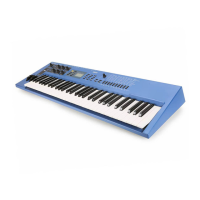34
With the exception of GM Bank 000, the XG Banks are only
partially allocated. To find out which voices are stored in the
above Banks check out the XG Voice list. Altogether there are
480 voices contained within the XG Banks. When choosing
sounds it is advisable to start with the basic sound (Bank
000) and then try out each Variation with the LSB value.
AMPLE:
Let‘s assume you are looking for a synth brass sound. As a
starting point select voice “Synthbras1”. The following Bank/
Program Changes are required:
Control 0 000 (MSB)
Control 32 000 (LSB)
Program 063 (= i.e. 062)
A quick glance at the XG Voice List reveals all of this
sound‘s Variations:
Bank 012 (Fast Decay) = “Quack Brass”
Bank 020 (Rsonant) = “RezSynBr”
Bank 024 (Attack) = “PolyBrss”
Bank 027 (Rezo Sweep) = “SynBras3”
Bank 032 (Detune 1) = “JumpBrss”
Bank 045 (Velo-Xfade) = “AnaVelBr”
Bank 064 (Other Wave) = “AnaBrss1”
To select the Variation you want, simply change the respec-
tive Bank number, for example increasing the LSB value to
012 would give you “Quack Brass”.
Table: XG Drum kits
(Performance mode and XG Mode)
Who is controlling whom?
Now that you are familiar with sound selection using Bank
and Program Changes, let‘s investigate how those sounds
can be changed from within a song using Controllers.
Simply, Controller messages allow real-time control of spe-
cific parameters over MIDI. The Controller messages are
either stored along with Bank and Program change com-
mands in the Setup Data preceding the song itself, or are
sent along with the note information in real-time.
We will introduce the CS1x‘s most relevant Controllers to
song production with this next table. Listed also are the Con-
troller values that the CS1x defaults to.
Table: The most important CS1x Controllers
Sound parameters like Resonance, Release, Attack, Cutoff
or Pan Position are edited relatively; they can be decreased
as well as increased, depending on the sound‘s factory set-
tings. It is important therefore to set every Controller initially
to the middle value 64 to ensure that the Knob settings actu-
ally correspond to the programmed Controller values. Not so
for Volume and Effect Send parameters. These work with
absolute values, i.e. the keyboard‘s parameters are consis-
tent with the respective Controller values.
Tip: To make life a little easier you can use a particular Con-
troller data block as Setup Data for each track in each song.
There are two files on the Tutorial disk to demonstrate how:
• “SETUPPF” = Performance mode Setup Data (Ch. 1 +
5-16)
• “SETUPXG”= Multi mode Setup Data (Ch. 1-16)
The System Exclusive Init data found at the beginning of
both files is used to initialise each mode‘s parameters. This
avoids older Multi settings from a previous song being used
by mistake. We now have to follow this data with any param-
eter settings that deviate from their initial defaults.
File “SETUPXG” contains additional Sys-Ex messages that
set up the Variation Effect (“2-Band EQ”).
A closer look at UTILITY function “Assign Ctrl No” reveals
where the CS1x gets its “Control Synthesizer” name. Here
you can use any Knob (1 – 6) and the Mod wheel to modify
default settings by assigning them to any of the above Con-
trollers. Simply move the desired Knob or the Mod wheel and
enter a new Controller number – it‘s that easy.
In order to keep a better perspective on the proceedings it
may be advisable in most cases to leave the factory default
settings alone. There are occasions however when changing
these settings can be very useful.
AMPLE:
Let‘s say you want to record real-time Pan Position
changes. Knobs 3 (Assign1/Data) and 6 (Assign2) that can
have any parameter assigned to them are however otherwise
engaged. All you need to do is to assign Knob 3 temporarily
to Controller 10 (Pan Position). Now you can record and freely
modulate the Pan Position with Knob 3. When you are done,
reassign Knob 3 to Controller #17 again (the default setting),
so that the Knob fulfils its intended function in the Perfor-
mance.
The use of Knobs in this way isn‘t limited to the Perfor-
mance. The Controller data generated by Knob movements is
always sent to the MIDI channel set as TRANS CH. in
Drumkit MSB LSB Prg
Standard Kit 127 000 001 (000)
Standard2 Kit 127 000 002 (001)
Room Kit 127 000 009 (008)
Rock Kit 127 000 017 (016)
Electro Kit 127 000 025 (024)
Analog Kit 127 000 026 (025)
Jazz Kit 127 000 033 (032)
Brush Kit 127 000 041 (040)
Classic Kit 127 000 049 (048)
SFX1 126 000 001 (000)
SFX2 126 000 002 (001)
Controller
No.
Parameter CS1x Default Setting
7 Volume 100
10 Pan 64
17 Knob 3 Parameter (nur Performance-Modus) 64
18 Knob 6 Parameter (nur Performance-Modus) 64
71 Filterresonanz (Knob 5) 64
72 AEG Release Time Knob 2) 64
73 AEG Attack Time (Knob 1) 64
74 Filterfrequenz (Knob 4) 64
91 Reverb Send 40 (Perf. Mode = 0)
93 Chorus Send 0
94 Variation Effect Send (XG Mode only) 0

